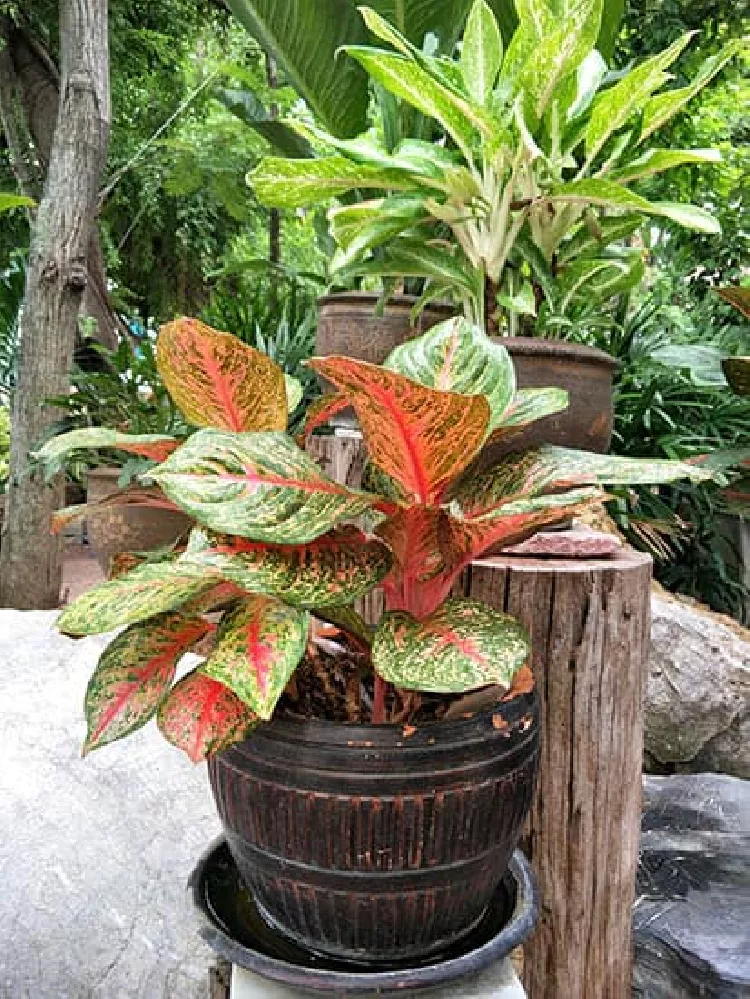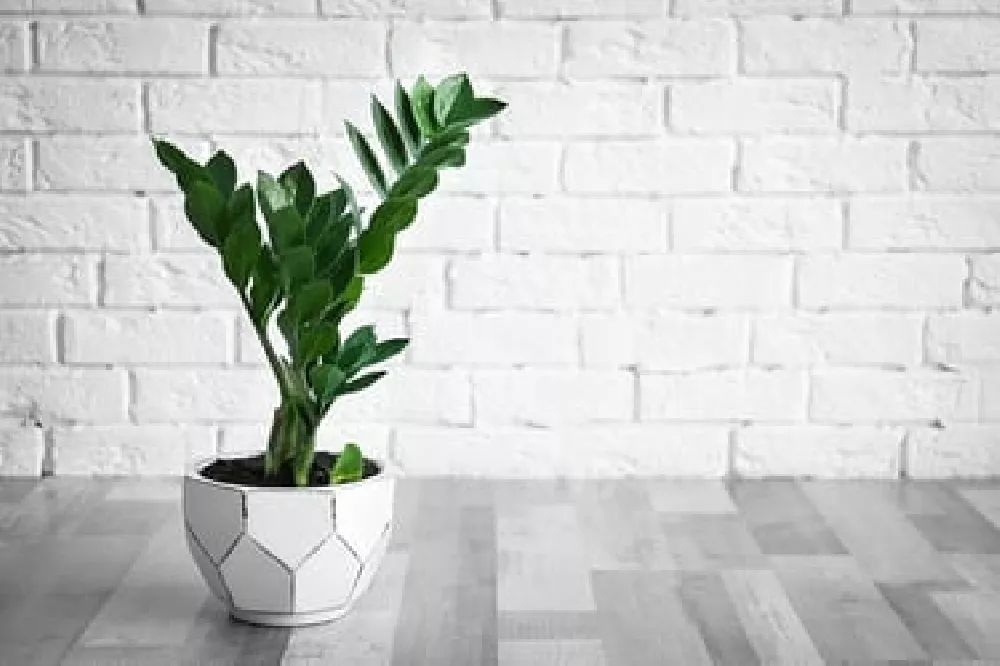- Home >
- Houseplants >
- Green Chinese Evergreen Plants
Green Chinese Evergreen Plants for Sale - Buying & Growing Guide
The Chinese Evergreen, or Aglaonema commutatum is an eye-catching indoor plant. These plants come in several different varieties. Gardeners can choose from plants with solid, emerald-green leaves, or patterned varieties infused with vibrant colors like red, pink, and yellow. Here are some other facts about Chinese Evergreen plants:
- Tolerant of low-light and fluorescent light conditions
- Well-suited for offices and environments with artificial light
- Great for beginner gardeners thanks to their low-maintenance care requirements
Enter your zip code to find nearby stores that may carry this plant.
Plant Care
Sunlight

Aglaonema thrives in indirect light, but will tolerate morning sun. Too much sunlight may burn the leaves.
Watering
Let soil dry out to 2 inches below the surface before watering, then give it a thorough drenching.
Fertilizing

Fertilize once or twice a year with a liquid, balanced fertilizer formulated for house plants.
Planting and Care
Planting instructions
Drainage is key to ensuring the health and longevity of your Chinese Evergreen, so be sure you select a pot with drainage holes. This will help excess water drain away and prevent root rot. You should also plant your Chinese Evergreen in a well-draining soil, like a mixture of soil and perlite, or orchid bark mix. Chinese Evergreens are known for being tolerant of low-light conditions, so these are optimal plants for areas of your home or office that do not receive much natural sunlight.
Watering and nutrients
While too much watering will harm a Chinese Evergreen Plant, they do enjoy moist soil. For best results, let the top 1 to 2 inches of soil dry out between waterings. This can mean letting one or two weeks pass in between waterings. Chinese Evergreens are somewhat drought-resistant, so it will cope just fine if a few extra days pass between waterings. This is preferable to overwatering, which can lead to root rot. When it comes to nutrients, Chinese Evergreens need minimal fertilizing — once or twice a year with a water-soluble houseplant fertilizer (10-10-10) is typically sufficient.
Pruning
One of the benefits of Chinese Evergreen Plants is that they do not require regular pruning, especially if you’re not overly concerned with the look and shape of your plant. In this case, removing dead leaves as needed is sufficient to keep your plant healthy. Chinese Evergreens naturally grow upward, but you can encourage your plant to grow outward by continually cutting back leaves. This will force the plant to direct its energy toward growing new leaves where the old ones leaves were cut, instead of putting energy into growing the main stems.
Pests and diseases
Another selling point of Chinese Evergreens is that they are largely resistant to most plant diseases. In most cases, any issues are related to overwatering, including root rot. Chinese Evergreens are also sensitive to build-up of minerals found in tap water, such as fluoride. To prevent this, water your Chinese Evergreen with distilled water. Watch out for pests such as spider mites, mealybugs, and aphids. If an infestation occurs, wash the plant with insecticidal soap or neem oil to eradicate the pests.
Temperature
Though this plant is easy to look after and is very undemanding in terms of its needs, the one caveat to this is temperature. This is a warmth-loving plant, and would ideally like to be in a temperature range of 65-80 degrees Fahrenheit, with 60 degrees Fahrenheit being just about the lowest temperature it will tolerate. Keep the plant in a warm part of the home away from windows or doors, where it might suffer as a result of cold draughts. Also, keep it away from any air conditioning units or fan heaters, which will quickly dry it out.
The Chinese Evergreen plant will not thrive if left in a little-used area of the home that doesn’t benefit from constant heat, such as a rarely used guest room or a cold conservatory or porch. Treat the Chinese Evergreen almost like a member of your family; keep it in a nice, warm space where it will be comfortable and reward you with lots of beautiful lush foliage.
Humidity
As a tropical and sub-tropical plant, the Chinese Evergreen enjoys moderate to high humidity. It will do fine in normal levels of humidity found in homes but would benefit from a light misting of water to increase humidity. You could also place your plant on a pebble tray with water on it. As the water among the pebbles evaporates, it increases the humidity of the air around the plant.
In its natural habitat, when the humidity is especially high, the plant will absorb moisture through its leaves. In times of very dry air, make efforts to increase humidity so that the health of the plant doesn’t suffer. Keep it away from drafts or heaters, which may cause the plant to dry out.
Light
The Chinese Evergreen is well-known for being a low-light plant, which is why it is particularly popular in offices with no windows. It will do well in shaded areas, though it can cope with moderate indirect light. It does not like to sit in direct sunlight, so do not house the plant on a windowsill or in the line of direct light. This plant will enjoy living in shaded areas of the home and is particularly good at livening up corners of your home where most plants cannot usually live.
Repotting
This plant will need to be re-potted at least every two years. Choose a pot no more than two sizes bigger than its current pot; a pot which is too big will cause problems for the plant because having a lot of soil around it that retains water will lead to the plant inadvertently getting soggy roots, which could lead to root rot.
Re-pot the plant by gently removing it from its current pot, and lightly separate the roots from the soil it currently sits in. At this point, it is an option to separate the plant into two halves and pot it up as two smaller individual plants. This is a good idea if your plant is getting too big and you would prefer to have several smaller plants. Alternatively, you could gift the second plant to a friend or family member.
The Chinese Evergreen plant makes a wonderful gift due to it being so easy to grow, having an appealing look about it, and also being a sign of fortune and good luck in China. If you intend to separate the plant into two when you repot it, ensure that you have multiple stems above soil level that can happily be split apart. Providing your roots are not pot-bound, then pulling the roots apart to create two new plants should be fairly easy with little harm caused to the roots.
If the plant has been sitting in its current pot for too long, then the roots may have become quite tangled and heavily bunched together. This does not mean that you can’t separate it into two or several plants, but just that you need to exercise more care not to injure the plant. Use a gentle touch to lightly untangle the roots; shaking them gently may help to ease the process along and free any bits of soil that are holding the roots together.
If the roots were heavily laden together, then expect some damage when separating them, but if put in the correct environment in their new pots, then they should recover well. Alternatively, if your roots are so entangled that they look too daunting to tackle at this point, repot the plant as a whole in a larger pot, allowing the roots space to spread out. In a few months’ time, make another attempt to separate the plant into two and repot. After having space to grow outwards themselves, you may find that they have naturally untangled themselves.
Re-potting your Chinese Evergreen has several benefits. It allows the plant more root space, therefore giving it the opportunity to grow and flourish further. Re-potting also gives the plant a refresh in terms of its nutrient environment. Fresh soil will be nutrient dense, giving the plant a nutrient boost.
Propagation
Propagation can be done with stem cuttings from this plant, although a more popular way to create new plants from the Chinese Evergreen is to split it into multiple pots from the roots as it grows.
To propagate from stem cuttings, you will need to prune a stem from the mother plant, which is several inches in length. Plant this in soil, using rooting hormone if you like to encourage root growth. Stem cuttings from this plant also grow well in water. Place the cutting in a glass of water and watch as roots begin to emerge over the period of several weeks. Once it has a strong root system, you can plant it in soil. Planting your cutting in water is not only an effective way to propagate, but it’s also a very interesting way to watch how the roots develop. This would be an excellent science lesson if you have children and a great way to get them interested in plants.
Stem cuttings will need heating from the underneath to root well. If this isn’t possible, choose to propagate in late spring or summer when temperature conditions are more favorable and your plant will be naturally warmed up in your home environment.
Propagation by separating a mature plant into two or more plants is a much easier way to derive several plants from one. It’s also instant, with the added benefit of preventing the mother plant from becoming too overgrown. To achieve this, simply remove the plant from its pot, gently separate the roots to divide the plant up, and then, repot the ‘new’ plants in smaller pots.
FAQs
How do I propagate a Chinese Evergreen plant?
To propagate from stem cuttings, prune a stem from the mother plant, and plant it in soil, using rooting hormone if you like. It’s best to propagate in late spring or summer, as stem cuttings need heat to root well. The other option is to simply remove the plant from its pot, gently separate the roots to divide the plant up, and then, repot the ‘new’ plants in smaller pots.
Are there multiple varieties of Chinese Evergreen plants?
Yes. There are several varieties of Chinese Evergreens available. The Aglaonema modestum has white striated green leaves growing from green stems. The ‘Siam Red’ Aglaonema has a more tropical look, with bright pink veins, while the ‘Harlequin’ Aglaonema has yellowish leaves with pink veins. The popular ‘Silver Queen’ Aglaonema has cream-colored patterns on dark green leaves, while the ‘Silver King’ Aglaonema has wide splashes of cream on a green base.
Are Chinese Evergreen plants poisonous?
Chinese Evergreen plants contain calcium oxalate crystals, which can cause skin irritation and be toxic if ingested. The plant does not pose much of a threat to humans, although it should be kept out of reach of children. The greater danger is to household pets, including cats and dogs, who may chew on the leaves and ingest the calcium oxalate. Symptoms of pet poisoning include vomiting, drooling, and difficulty swallowing.
How large do Chinese Evergreen plants grow?
A typical, healthy Chinese Evergreen plant will grow to be about 3 feet high and 3 feet wide. These plants are slow-growing, so they will take a few years to reach their full size. Growth can also be controlled by regular pruning, if you want to keep your Chinese Evergreen plant smaller to better fit in your chosen location. To encourage growth, re-pot the plant at least once every two years.











